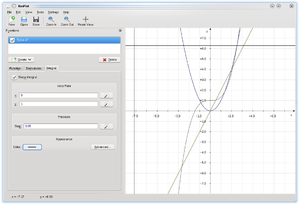Scratchpad/www-rework/Batch1: Difference between revisions
(added kdialog) |
|||
| Line 94: | Line 94: | ||
== kdialog == | == kdialog == | ||
Screenshot sent: no<br> Name: Kdialog<br>Description: [can be HTML or wiki markup] | |||
'''Kdialog''' allows you to display dialog boxes from shell scripts. | |||
The syntax is very much inspired from the "dialog" command (which shows text mode dialogs). | |||
Features (optional): | |||
Homepage: <br> | |||
ID on kde-apps.org: [none] <br> | |||
Page on Userbase: [empty] <br> | |||
ID of subforum on forum.kde.org: 108 <br> | |||
Link to handbook: | |||
http://techbase.kde.org/Development/Tutorials/Shell_Scripting_with_KDE_Dialogs<br> | |||
IRC channel(s): <br> | |||
Mailing lists: <br> | |||
Project name on cia.vc: <br> | |||
Bugzilla component: general <br> | |||
== keditbookmarks == | == keditbookmarks == | ||
Revision as of 23:47, 16 January 2010
Module kdeaccessibility
kmag
Screenshot sent:
Name: Kmag (KMagnifier)
Description:
KMagnifier (or kmag, its unix name) is a small utility for Linux to magnify a part of the screen. It was initially written for KDE 1, before becoming dormant. The development was then picked up by me and KMagnifier got its new life. It is currently being maintained/developed actively. KMagnifier is very useful for people with visual disabilities and for those working in the fields of image analysis, web development etc.
Features (optional):
Homepage: http://kmag.sourceforge.net/
ID on kde-apps.org:
Page on Userbase:
ID of subforum on forum.kde.org:
Link to handbook: http://kmag.sourceforge.net/doc.html
IRC channel(s):
Mailing lists:
Project name on cia.vc:
Bugzilla component:
kmousetool
Screenshot sent:
Name: KMouseTool
Description: KMouseTool is a Linux-based KDE program. It clicks the mouse for you, so you don't have to. KMouseTool works with any mouse or pointing device.
Features:
Clicking Dragging
Homepage: http://accessibility.kde.org/aids/kmousetool.php
ID on kde-apps.org:
Page on Userbase: http://accessibility.kde.org/aids/kmousetool.php
ID of subforum on forum.kde.org:
Link to handbook:
IRC channel(s):
Mailing lists:
Project name on cia.vc:
Bugzilla component:
kmouth
ksayit
ktts
Module kdeadmin
kcron
kdat
knetworkconf
ksystemlog
ksysv
kuser
Module kdebase
dolphin
kappfinder
kdepasswd
kdialog
Screenshot sent: no
Name: Kdialog
Description: [can be HTML or wiki markup]
Kdialog allows you to display dialog boxes from shell scripts. The syntax is very much inspired from the "dialog" command (which shows text mode dialogs).
Features (optional):
Homepage:
ID on kde-apps.org: [none]
Page on Userbase: [empty]
ID of subforum on forum.kde.org: 108
Link to handbook:
http://techbase.kde.org/Development/Tutorials/Shell_Scripting_with_KDE_Dialogs
IRC channel(s):
Mailing lists:
Project name on cia.vc:
Bugzilla component: general
keditbookmarks
kfind
kinfocenter
konqueror
konsole
kwrite
Module kdeedu
blinken
cantor
kalgebra
kalzium
kanagram
kbruch
kgeography
khangman
kig
kiten
klettres
kmplot
Screenshot sent:

Name: KmPlot
Description:
KmPlot is a program to draw graphs, theit integrals or their derivations. It supports different systems of coordinates link the carthesic or the polar system. The graphs can be colorized and the view is scalable, so that you are able to zoom to the level yo need.
Features (optional): please add features-section
Homepage: http://edu.kde.org/kmplot/
Page on Userbase: http://edu.kde.org/kmplot/
ID of subforum on forum.kde.org: 21
Link to handbook: http://docs.kde.org/stable/en/kdeedu/kmplot/index.html
IRC channel(s): #kde-edu
Mailing lists: [email protected]
Project name on cia.vc: kde/kmplot
Bugzilla component: kmplot
kstars
ktouch
kturtle
kwordquiz
marble
parley
Screenshot sent: no
Name: Parley
Description: [can be HTML or wiki markup]
Parley is a program to help you memorize things.
Parley supports many language specific features but can be used for other learning tasks just as well. It uses the <a href=\"http://en.wikipedia.org/wiki/Spaced_repetition\">spaced repetition</a> learning method, also known as flash cards.
Creating new vocabulary collections with Parley is easy, but of course it is even better if you can use some of our premade files. Have a look at the <a href=\"http://kde-files.org/index.php?xcontentmode=687\">KDE-Files.org</a> page or use the \"Download New Collections\" feature directly.
Features (optional):
Different test types
Mixed Letters (order the letters, anagram like) to get to know new words
Multiple choice
Written tests - type the words (including clever correction mechanisms)
Example sentences can be used to create 'fill in the gap' tests
Article training
Comparison forms (adjectives and/or adverbs)
Conjugations
Synonym/Antonym/Paraphrase
Fast test setup with all options in one dialog
More than two languages (for example English, Chinese Traditional and Chinese Simplified)
Find words (also by word type) quickly
Easy lesson management
Premade vocabulary files ready to use
Share and download vocabulary using Get Hot New Stuff
Open XML file format (shared with KWordQuiz, Kanagram and KHangMan) that can be edited by hand and is easily usable with scripts
Homepage: http://edu.kde.org/parley
ID on kde-apps.org: 66741
Page on Userbase: [empty]
ID of subforum on forum.kde.org: 21
Link to handbook: http://docs.kde.org/stable/en/kdeedu/parley/index.html
IRC channel(s): #kde-edu
Mailing lists: [email protected], [email protected]
Project name on cia.vc: kde/parley
Bugzilla component: parley
